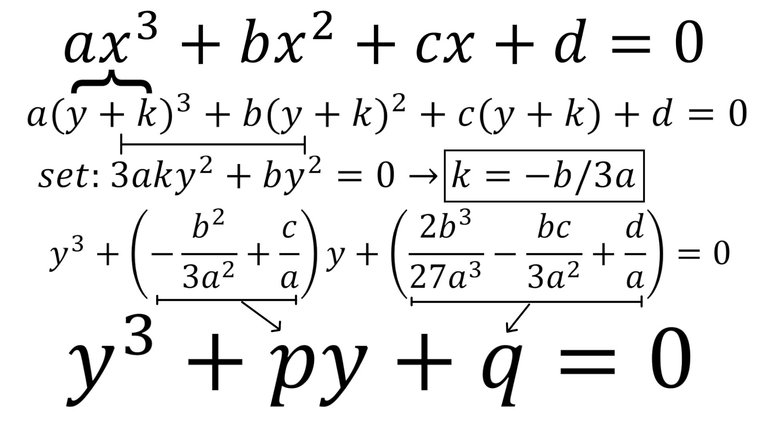In this video I go over the first step in deriving the Cubic Formula, which is to eliminate the x2 term from the Cubic Equation by using the PQ Substitution method. This allows us to later apply Vieta's substitution to obtain a quadratic formula, which we can solve. As in the PQ Quadratic Formula method, I set x = y + k and then expand the powers and select a k value such that the x2 terms get eliminated. Then rearranging and defining p and q as the terms for the coefficients of the x1 and x0, we obtain the PQ version of the Cubic Equation.

Time stamps
- Step 1: Get rid of x2 term using PQ Substitution in order to later apply Vieta's substitution to get a quadratic formula: 0:00
- Applying PQ substitution to cubic equation by letting x = y + k: 1:46
- Expanding out the y2 terms only: 3:20
- Equate y2 terms to equal zero and solve for k: 5:10
- Recap of Pascal's Triangle: https://en.wikipedia.org/wiki/Pascal%27s_triangle 6:00
- Plugging in our k to cancel out terms and rearrange equation: 7:43
- Divide new Cubic Equation by a: 13:40
- Substitute p and k to obtain the new PQ Cubic Equation: 14:45
Notes and playlists
- Summary: https://peakd.com/hive-128780/@mes/wwtmttrs
- Playlist: https://www.youtube.com/playlist?list=PLai3U8-WIK0EF05ExjzLbB64NgUjoV1hl
- Notes: https://peakd.com/hive-128780/@mes/dzekfnxh .
Become a MES Super Fan! https://www.youtube.com/channel/UCUUBq1GPBvvGNz7dpgO14Ow/join
DONATE! ʕ •ᴥ•ʔ https://mes.fm/donate
SUBSCRIBE via EMAIL: https://mes.fm/subscribe
MES Links: https://mes.fm/links
MES Truth: https://mes.fm/truth
Official Website: https://MES.fm
Hive: https://peakd.com/@mes
Email me: contact@mes.fm
Free Calculators: https://mes.fm/calculators
BMI Calculator: https://bmicalculator.mes.fm
Grade Calculator: https://gradecalculator.mes.fm
Mortgage Calculator: https://mortgagecalculator.mes.fm
Percentage Calculator: https://percentagecalculator.mes.fm
Free Online Tools: https://mes.fm/tools
iPhone and Android Apps: https://mes.fm/mobile-apps
▶️ 3Speak
